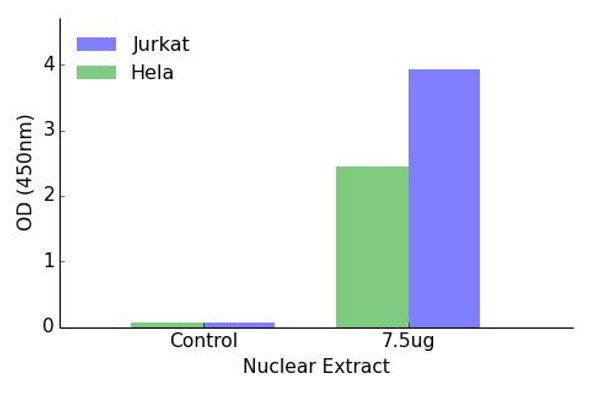Description
STAT1 Transcription Factor Activity Assay
The STAT1 Transcription Factor Activity Assay by AssayGenie is a powerful tool for researching the activity of the STAT1 transcription factor in cells. This assay kit is specifically designed for accurate and reliable measurement of STAT1 activity in cell lysates, making it ideal for studying signaling pathways, gene regulation, and immune responses.STAT1 is a key transcription factor involved in the regulation of gene expression in response to various stimuli, such as cytokines, growth factors, and pathogens.
Dysregulation of STAT1 activity has been implicated in various diseases, including cancer, autoimmune disorders, and infectious diseases, highlighting the importance of studying its activity.With high sensitivity and specificity, the STAT1 Transcription Factor Activity Assay provides researchers with a valuable tool for studying the role of STAT1 in cellular processes and disease pathogenesis. Trust AssayGenie for accurate and reproducible results in your research endeavors.
| Product Name: | STAT1 Transcription Factor Activity Assay |
| Product Code: | TFAB00165 |
| Target: | STAT1 |
| Synonyms: | Transcription factor ISGF-3 components p91/p84 |
| Reactivity: | Human, Mouse, Rat |
| Sample Types: | Nuclear or cell lysates |
The Assay Genie STAT1 transcription factor activity assay allows for the detection and qualitative analysis of endogenous levels of activated transcription factors in a variety of nuclear and cell lysates
Assay Genie ELISA kits are designed to significantly reduce experiment time and ensure sensitivity and flexibility for high-throughput screening.
| Assay Time: | 4.5 hours |
| Detection Method: | Colorimetric 450 nm |
| Size: | 12 x 8-Well Microstrips |
| Storage: | 4°C for 6 months |
| UniProt Protein Function: | STAT1: transcription factor of the STAT family. Phosphorylated and activated by receptor-associated kinases downstream of certain receptor tyrosine kinases, GPCRs, and receptors for various interleukins and interferons. Forms homo- or heterodimers that translocate into the nucleus where they regulate transcription. Two alternatively spliced isoforms have been described. |
| UniProt Protein Details: | Protein type:DNA-binding; Transcription factor Chromosomal Location of Human Ortholog: 2q32.2 Cellular Component: axon; cytoplasm; cytosol; dendrite; nuclear chromatin; nucleolus; nucleoplasm; nucleus; perinuclear region of cytoplasm Molecular Function:double-stranded DNA binding; enzyme binding; identical protein binding; protein binding; protein homodimerization activity; signal transducer activity; transcription factor activity; tumor necrosis factor receptor binding Biological Process: apoptosis; blood circulation; defense response to virus; endothelial cell migration; JAK-STAT cascade; negative regulation of angiogenesis; negative regulation of endothelial cell proliferation; negative regulation of I-kappaB kinase/NF-kappaB cascade; negative regulation of transcription from RNA polymerase II promoter; negative regulation of viral protein levels in host cell; positive regulation of mesenchymal cell proliferation; positive regulation of smooth muscle cell proliferation; positive regulation of transcription from RNA polymerase II promoter; positive regulation of transcription, DNA-dependent; regulation of apoptosis; regulation of transcription from RNA polymerase II promoter; response to cAMP; response to cytokine stimulus; response to peptide hormone stimulus; transcription, DNA-dependent; tumor necrosis factor-mediated signaling pathway; viral reproduction Disease: Immunodeficiency 31a; Immunodeficiency 31b; Immunodeficiency 31c |
| NCBI Summary: | The protein encoded by this gene is a member of the STAT protein family. In response to cytokines and growth factors, STAT family members are phosphorylated by the receptor associated kinases, and then form homo- or heterodimers that translocate to the cell nucleus where they act as transcription activators. This protein can be activated by various ligands including interferon-alpha, interferon-gamma, EGF, PDGF and IL6. This protein mediates the expression of a variety of genes, which is thought to be important for cell viability in response to different cell stimuli and pathogens. Two alternatively spliced transcript variants encoding distinct isoforms have been described. [provided by RefSeq, Jul 2008] |
| UniProt Code: | P42224 |
| NCBI GenInfo Identifier: | 2507413 |
| NCBI Gene ID: | 6772 |
| NCBI Accession: | P42224.2 |
| UniProt Secondary Accession: | P42224,Q53S88, Q53XW4, Q68D00, Q9UDL5, A8K989, B2RCA0 D2KFR8, D3DPI7, |
| UniProt Related Accession: | P42224 |
| Molecular Weight: | |
| NCBI Full Name: | Signal transducer and activator of transcription 1-alpha/beta |
| NCBI Synonym Full Names: | signal transducer and activator of transcription 1 |
| NCBI Official Symbol: | STAT1 |
| NCBI Official Synonym Symbols: | CANDF7; IMD31A; IMD31B; IMD31C; ISGF-3; STAT91 |
| NCBI Protein Information: | signal transducer and activator of transcription 1-alpha/beta |
| UniProt Protein Name: | Signal transducer and activator of transcription 1-alpha/beta |
| UniProt Synonym Protein Names: | Transcription factor ISGF-3 components p91/p84 |
| Protein Family: | Signal transducer and activator of transcription |
| UniProt Gene Name: | STAT1 |
| UniProt Entry Name: | STAT1_HUMAN |






